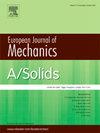空间碎片冲击下单片和复合护盾的性能
IF 4.4
2区 工程技术
Q1 MECHANICS
引用次数: 0
摘要
为长期任务设计空间结构需要考虑到空间碎片的影响。这包括评估通常用于航空航天应用的轻质、高强度复合护罩对超高速撞击的响应。关于这一问题的现有研究主要集中在确定空间碎片的大小,如球体、圆柱体、圆盘和环,这些碎片必须被屏蔽。然而,对椭球碎片的研究较少。预测空间碎片的平均剩余速度和确定防护层的弹道极限对于确保结构安全抵御空间碎片的冲击具有重要意义。研究了Al-2024-T3铝合金、尼龙66聚合物(NY66)、尼龙66纤维(NYF66)及其复合防护材料在椭球碎片超高速冲击下的防弹性能。形状因子(SF)基于长径比(L/d)对椭球状碎片进行分类。对Al-2024-T3的Johnson-Cook模型、NY66和NYF66的弹塑性水力模型进行了标定,并在LS-DYNA程序上进行了仿真,验证了实验结果。根据计算结果,导出了弹道极限和剩余速度的修正方程。其中NYF66表现出较好的抗弹道性。复合材料a型对超高速撞击效果最优,c1型对高速撞击效果较好。本文章由计算机程序翻译,如有差异,请以英文原文为准。
Behavior of monolithic and composite shields under space debris impact
Designing space structures for long-duration missions requires accounting for the impact of space debris. This involves assessing lightweight, high-strength composite shields, commonly used in aerospace applications, for their response to hypervelocity impacts. The available research on this subject mostly focuses on determining the size of space debris such as spheres, cylinders, disks, and rings which must be resisted by the shields. However, there have been fewer studies on ellipsoidal debris. Predicting the average residual velocity of space debris and determining a ballistic limit of shields are important for ensuring structural safety against space debris impact. This study investigates the ballistic performance of Al-2024-T3 aluminum alloy, nylon 66 polymer (NY66), nylon 66 fiber (NYF66), and their composite shields under hypervelocity impacts with ellipsoidal debris. The shape factor (SF), based on the length-to-diameter (L/d) ratio, categorizes the ellipsoidal debris. The Johnson-Cook model for Al-2024-T3 and the Elastic-Plastic Hydro model for NY66 and NYF66 were calibrated and the simulations performed on LS-DYNA code validated with experimental results. Modified equations for ballistic limit and residual velocity were derived from computational results. Among the materials, NYF66 showed superior ballistic resistance. Composite Type-A was optimal for hypervelocity impacts, while Type-C1 excelled in high-velocity impacts.
求助全文
通过发布文献求助,成功后即可免费获取论文全文。
去求助
来源期刊
CiteScore
7.00
自引率
7.30%
发文量
275
审稿时长
48 days
期刊介绍:
The European Journal of Mechanics endash; A/Solids continues to publish articles in English in all areas of Solid Mechanics from the physical and mathematical basis to materials engineering, technological applications and methods of modern computational mechanics, both pure and applied research.

 求助内容:
求助内容: 应助结果提醒方式:
应助结果提醒方式:


